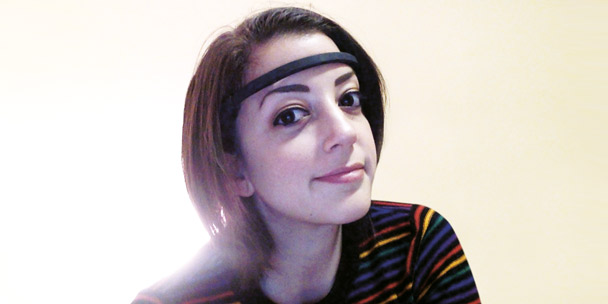Health & Fitness
#lifereboot: Stephanie Gilman becomes a Zen master
Our columnist trains her brain to chill with the Muse headband.
by : Stephanie Gilman- Mar 3rd, 2015

I’m lying in bed, listening to the calming sounds of rippling water, when a thought pops into my head: The fridge is empty. I have to buy groceries. What should I make for dinner this week? One thought leads to another, and I notice that the quiet nature sounds have transformed into strong winds and crashing waves. I stop my rambling thoughts in their tracks and focus on my breathing. As I count the breaths (one in…two out…three in…), the wind is replaced by the soothing stream and then, in the distance, the soft sound of birds chirping happily, signalling that the storm has, indeed, passed.
This sequence of events was the result of the varying levels of activity in my brain. No, I have not spontaneously developed magical powers. (How great would that be, though?) My ability to control nature sounds comes from my newest fashion accessory: a sleek headband that goes by the name of “Muse.”
Muse is a brain-sensing headband from Toronto-based tech company Interaxon that can help train the mind to be more calm and focused and less stressed. It senses the pulses of electricity that bounce between the 100 billion neurons in the human brain. When one’s mind is active, there’s a lot of bouncing going on. The goal is to slow things down to a peaceful, rhythmic hop. This claim sounded pretty good to me, as I’ve been looking for different ways to lower stress in my life and halt the numerous anxious thoughts floating around in my mind.
READ MORE: Stephanie Gilman’s journey in photos
After putting on the headband, I start the “Calm” app, which guides me through a simple meditation exercise. Immediately I start to get real-time feedback on how I’m doing. As thoughts enter my mind and begin to run amok, the winds pick up, signalling me to come back into the moment and calm my mind. When my mind is very calm, I’m rewarded with more points and the sound of birds tweeting. Essentially, it’s meditation as a game. But does it work?
I spent a month with Muse, using it in the evenings to help relax and clear the thoughts of the day. My first session with Muse told me I was 27-percent calm – pretty pitiful and not really where I want to be in my life right now. But within a few days I had achieved a “score” of 74-percent calm and received 15 “bonus birds” as a reward for my relaxed mental state. “This meditation stuff isn’t so hard,” I thought. “I’ve already mastered it; I am pretty much Buddha.”
Oh, how quickly the mighty fall.
My moment as a Muse champion did not last long. My sessions were all over the place, with several under 50 percent. Occasionally I’d spike back up to a high level of calm, but it rarely lasted more than a day. Once, I even scored a pathetic 1 percent. A master of Zen I was not.
Although I didn’t necessarily improve all that much at calming my mind, I did keep at it, making sure that I took at least a few minutes out of each day to sit, breathe and meditate. Apart from sporadically achieving a decent score, I wasn’t so sure the routine was having any major effect on my stress levels or my ability to control them…until a few weeks later, when I began to notice worsening pain around my ribs.
READ MORE: Stephanie Gilman photographs her grateful moments
When you’ve had cancer, any new pain can be cause for alarm. It’s one of the (many) unfortunate aftereffects I’m now stuck dealing with. So when I started to feel some muscular and bone pain on the side where my cancer once lived, my thoughts immediately spiralled down a familiar dark and frantic path. What if the cancer is in my bones? How long will I have left to live? How will I tell my family? What if I die before the series finale of The Americans and never know how it ends?
Tears started to burn my eyes as I ruminated about the many awful things that might still happen to me and the anger I felt at having to live with those types of possibilities. I cursed myself for not renewing the prescription for anxiety medication that was given to me when I was first diagnosed. I was left with only one option: to attempt to calm my mind and halt the negative thoughts. I sat down, closed my eyes and began counting my breaths, in and out, in and out, until my heart stopped racing and I started to feel at ease. My body relaxed, and I felt the panic dissipating. The exercise appeared to actually be working, as it slowly but surely brought me down from the ledge I had created for myself. I didn’t need to hear the wind subside or the birds chirping to know that I had managed to succeed at something that once seemed impossible.
READ MORE: Stephanie Gilman’s 5 steps to facing her fears
A few days later, I had a bone scan. I learned that everything was fine, which was a huge relief. That said, I know that I will never be cured of my anxiety and that these moments of panic are something I will likely have to deal with for the rest of my life. That’s what it is to live a life filled with uncertainty. It’s not easy, but I know now that I am moving in the right direction and learning to cope with the many question marks and what-ifs that surround me. I haven’t mastered it yet. But if I focus and listen very closely, I can almost hear that babbling brook and the sweet sound of singing birds.
The Muse measures electrical impulses in your brain and provides instant feedback when it’s time to chill ($299, choosemuse.com). Enter to win a Muse by sharing your #lifereboot story at here.
READ MORE:
Stephanie Gilman’s journey to reboot her life
#lifereboot: Stephanie Gilman walks on the edge
How our #lifereboot columnist spent a day in silence
Newsletter
Join our mailing list for the latest and biggest in fashion trends, beauty, culture and celebrity.
Read Next

Fashion
H&M's Latest Designer Collab With Rokh Just Dropped (And It's So Good)
We chatted with the emerging designer about the collaboration, his favourite pieces and more.
by : Melissa Fejtek- Apr 18th, 2024

Culture
5 Toronto Restaurants to Celebrate Mother’s Day
Treat your mom right with a meal at any of these amazing restaurants.
by : Rebecca Gao- Apr 18th, 2024

Beauty
Tested and Approved: Your New Hydrating Skincare BFF
This new product has all of your skin’s thirst-quenching needs covered.
by : ELLE Canada- Apr 17th, 2024


